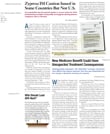The lifetime risk of suicide among persons diagnosed with schizophrenia is about half of the rate routinely quoted in the psychiatric literature, according to a meta-analysis of 61 studies.
Rather than the conventional estimate that 10 percent of those with schizophrenia will die by suicide, the new study estimates that 5.6 percent will commit suicide during their lifetime, with most deaths occurring shortly after the onset of illness, said Brian A. Palmer, M.D., M.S., M.P.H., V. Shane Pankratz, Ph.D., and John Michael Bostwick, M.D., of the Mayo Medical School in Rochester, Minn. The results remained the same regardless of whether newer (DSM-III or later) or older diagnostic criteria were applied.
The previous estimate was based on the number of suicides listed as the cause of death among the total number of people with schizophrenia who died during the course of follow-up, reported the researchers in the March Archives of General Psychiatry. That simply gave the proportionate mortality—the percentage of dead people who had schizophrenia and died by suicide. Such an approach works only when all subjects are observed until they die—a practical impossibility—or if suicides as a proportion of all deaths occur at the same rate over time, which they do not. Most suicides among persons with schizophrenia occur in the first few years following diagnosis.
“Proportionate mortality provides information only about the dead,” they said. “The direct use of proportionate mortality rates... assumes a constant rate of suicide over a lifetime and will therefore overestimate suicide risk.”
Using the proportionate mortality method among new-onset cases resulted in a suicide rate of 30.6 percent, a “dramatic” overweighting of lifetime risk. A more meaningful number would be the case fatality rate, the percentage of the total sample who killed themselves, according to the researchers.
They initially estimated a suicide rate of 4.9 percent. However, after factoring in the length of the studies included in the meta-analysis, they concluded that 5.6 percent of persons with schizophrenia will commit suicide at some point following diagnosis, explained Pankratz, the statistician among the authors. “This number is a better reflection of the true percentage of schizophrenics who will suicide, as it accounts for differences in the length of the various studies.”
While using a statistical sword to cut the expected suicide rate in half may seem like an important accomplishment, a 5 percent rate still represents a major risk, said Carol A. Tamminga, M.D., a professor of psychiatry at Texas Southwestern Medical Center in Dallas. She added that epidemiological studies like this deserve attention.
“These new methodologies are needed because the use of suicide rates was not truly scientific before,” she said. “Sometimes people used the 10-percent figure to simply underscore the importance of the issue.”
Palmer, Pankratz, and Bostwick reviewed the medical literature using online databases (MEDLINE and PsychInfo) and hand searching bibliographies. Out of 632 relevant papers, they found 32 studies of 25,578 patients with schizophrenia who were enrolled at various times in the course of their illness and 29 studies of 22,598 patients who were identified at either illness onset or at first hospital admission.
“First-admission and new-onset studies more accurately estimate suicide risk because they include the initial years of the illness when death by suicide is most likely,” they said.
While welcoming the meta-analysis, Tamminga would like to see further research examining the effects of variables other than age, including gender, comorbidities, medication use, and care setting.
For instance, she said, it would be helpful to see whether the use of second-generation antipsychotic drugs were associated with lower suicide rates, or whether there were differences between patients in hospital and those in community care, where more lethal means of suicide were available, or why more people without a diagnosis of schizophrenia who commit suicide are depressed but incidence of depression is lower among people with schizophrenia.
“People with schizophrenia who commit suicide are not necessarily depressed but see themselves in a psychosocial situation that seems hopeless to them,” said Tamminga. “Clinicians must help them find meaning and purpose in their lives rather than demoralization.”
Since suicide is concentrated in the early course of schizophrenia, wrote Palmer, Pankratz, and Bostwick, “intervention and prevention efforts are therefore best directed toward [patients in] the early stages of the illness.”
Arch Gen Psychiatry 2005 62 247
